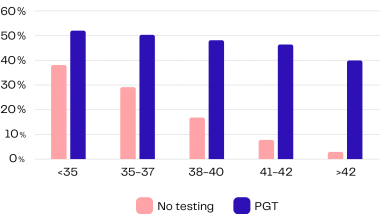Používáte nepodporovaný, zastaralý internetový prohlížeč. Stránky v něm nemusí být správně zobrazeny, mohou být pomalé a nemusí správně fungovat. Zaktualizujte si prohlížeč nebo si nainstalujte nový. Doporučujeme použití některého z následujících prohlížečů: Google Chrome, Edge, Mozilla Firefox


PGT: Preimplantation genetic testing
Every parent's greatest wish is to have a healthy child. By determining the genetic makeup of embryos, we can detect problems in time. We then only transfer embryos that have a greater chance of producing a healthy baby to the uterus.
Genetic abnormalities are a common cause of early miscarriages in the first trimester of pregnancy. Preimplantation testing helps prevent these losses. There are three types of preimplantation testing - PGT-A, PGT-SR and PGT-M.
Book a consultationPreimplantation genetic testing for aneuploidies (PGT-A)
Preimplantation genetic testing for aneuploidies (PGT-A) - formerly preimplantation genetic screening (PGS). Tests for chromosomal abnormalities before the transfer of the embryo to the uterus. The wrong number of chromosomes is one of the causes of the embryo’s failure to implant (nest) in the endometrium or miscarriage in the early stages of pregnancy.
Preimplantation genetic testing for structural chromosomal abnormalities (PGT-SR)
The PGT-SR test is particularly recommended if one or both partners have a history of genetic disorders in the family. This test is used to rule out chromosome rearrangements (e.g. translocations) leading to miscarriages or the birth of a child with multiple developmental defects.
Preimplantation genetic testing for monogenic diseases (PGT-M)
PGT-M (formerly known as PGD) is indicated for couples with a known risk of transmitting a serious genetic disease. PGT-M testing is performed prior to embryo transfer and is a method designed for couples with a genetic burden that minimises the risk of transmitting serious defects and hereditary diseases to their offspring.
PGT increases the chance of an embryo implanting in the uterus and reduces the likelihood of miscarriage
According to data from the USA, PGT has a very positive effect on the success of embryo implantation in a woman's uterus. However, there is a significant difference in the rate of success for clients over the age of 40.

PGT also significantly reduces the frequency of miscarriages, especially in women over the age of 40.

How does PGT work?
We wait for 120 hours after fertilisation, when the embryo has a greater number of cells.
We carefully separate one or more cells and analyse them.
The analysis is carried out using various methods – FISH (fluorescence in situ hybridisation) aCGH (microarray-based comparative genomic hybridisation), PCR (polymerase chain reaction).
The embryo is not damaged by this intervention and is frozen using vitrification. Once PGT results are available, it can be used for transfer.
We will recommend the best embryos for transfer to the uterus after evaluating the results.

When is this method indicated?
-
In case of repeated miscarriages
-
If the mother is older
-
If chromosomal abnormalities are found in either of the partners.
-
If the couple has repeatedly undergone unsuccessful embryo transfers in IVF cycles.
-
Following treatment of oncological diseases associated with radiation or chemotherapy, etc.
Book a consultation and we’ll see how we can help
Other laboratory methods
ICSI
ICSI is the injection of sperm directly into an egg. This significantly increases the chance of fertilisation.
More informationEmbryoScope
We can increase the chances of pregnancy by selecting only the best quality embryos for transfer. We can identify these through continuous monitoring in EmbryoScope.
More informationPESA/MESA/TESE
In the absence of live sperm in the ejaculate, there is the possibility of obtaining sperm surgically from the epididymis (PESA or MESA) or testis (TESE).
More informationEmbryoGen / BlastGen
EmbryoGen and BlastGen are sequential culture media meticulously engineered to closely emulate the natural developmental progression of embryos.
More informationAssisted hatching
This method is used to disrupt the protective envelope (outer shell) of the embryo in order to make it easier to implant (nest) in the uterus.
More informationMethods of infertility treatment
IVF with egg donation
If a woman cannot conceive and her partner's sperm are healthy, we use donor eggs fertilised with the partner's sperm.
More informationIVF using donor embryos
Donated eggs and donated sperm are used for in vitro fertilisation.
More informationIVF using donor sperm
For couples who cannot conceive naturally and the woman's eggs are healthy, we can use donor sperm from a suitable anonymous donor to fertilise the eggs.
More informationIVF using own eggs
We recommend IVF if the couple cannot conceive naturally.
More information





